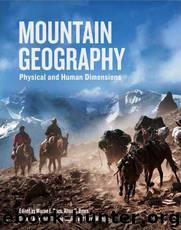Mountain Geography by Martin Price

Author:Martin Price [Price, Martin]
Language: eng
Format: epub
ISBN: 9780520254312
Publisher: University of California Press
Published: 0101-01-01T00:00:00+00:00
Timberline Floristics
The vast majority of timberline trees of northern hemisphere mountains are pine (Pinus), spruce (Picea), and fir (Abies). These genera are represented by similar species throughout the northern hemisphere and occupy similar ecological niches, as illustrated by the ecology of the white-bark pine (P. albicaulis), a western North America timber-line species, and its close relatives in Eurasia. Whitebark pine produces large, wingless seeds that rely on a bird, the Clark’s nutcracker (Nucifraga columbiana), for seed dispersal through the harvesting and caching of seeds as a winter food source (Vander Wall and Balda 1977). Unused portions of these caches subsequently serve as an important seed source for seedling establishment. An identical relationship exists between pines and nutcrackers in Western Europe from the Alps to the Caucasus (e.g., between P. cembra and Nucifraga caryocatactes), and in the mountains of eastern Asia, between P. pumila and N. caryocatactes var. japonicus (Holtmeier 1973).
Other, less common genera of the pine family found at timberline include hemlocks and larches. The timberline hemlocks are represented by mountain hemlock (Tsuga mertensiana) in the Cascade and Olympic ranges of western North America. The deciduous larch (Larix spp.) is represented by several species in North America and Eurasia. Juniper (Juniperus communis) is also found in most northern hemisphere mountains, but usually grows as a scattered and low shrub (Wardle 1974).
Broadleaf deciduous trees form the timberline in some areas, especially in Scandinavia, eastern Asia, and parts of the Himalaya (Troll 1973). The dominant genus is birch, but other genera such as aspen, alder, and beech also occur. The upper treeline occurrence of broadleaf genera usually occurs in the absence of competing conifers. Broadleaf deciduous trees such as willow, birch, alder, and maple may also be present near timberline in areas experiencing slope instability and avalanches. These trees are well adapted for unstable slopes because of their ability to resprout from their root systems and because their flexible stems resist breakage by moving snow.
Timberline areas in tropical and southern hemisphere mountains are typically smaller but more floristically diverse than in the northern hemisphere (Wardle 1974). Timberline occurs along the axis of the Andes in South America, but is limited to the tropical mountains in Africa and exists as scattered enclaves in Australasia, with the exception of New Zealand. Broadleaf evergreen species, particularly Nothofagus, dominate timberline throughout the southern hemisphere. The timberline species of Nothofagus are generally evergreen, but can also occur in deciduous form in the drier and more continental areas of Patagonia, Tasmania, and New Zealand. Coniferous species of Araucaria, Podocarpus, Libocedrus, and Papuacedrus may also occur at timberline but are subdominant to Nothofagus. In Australia, upper timberline is dominated almost entirely by the snow gum (Eucalyptus niphophila) (Costin 1959).
Members of the heath family (Ericaceae) dominate the timberline vegetation of many tropical mountains, forming an “ericaceous belt” (Hedberg 1951; Troll 1968; Wesche et al. 2000). The ecological significance of Ericaceae in tropical mountains is unknown, but many species are fire resistant and able to reproduce quickly following fire and other types of disturbance (Sleumer 1965; Wesche et al.
Download
This site does not store any files on its server. We only index and link to content provided by other sites. Please contact the content providers to delete copyright contents if any and email us, we'll remove relevant links or contents immediately.
Man-made Catastrophes and Risk Information Concealment by Dmitry Chernov & Didier Sornette(5650)
The Revenge of Geography: What the Map Tells Us About Coming Conflicts and the Battle Against Fate by Kaplan Robert D(3961)
Zero Waste Home by Bea Johnson(3655)
In a Sunburned Country by Bill Bryson(3368)
COSMOS by Carl Sagan(3348)
Good by S. Walden(3347)
The Fate of Rome: Climate, Disease, and the End of an Empire (The Princeton History of the Ancient World) by Kyle Harper(2873)
Camino Island by John Grisham(2719)
A Wilder Time by William E. Glassley(2690)
Organic Mushroom Farming and Mycoremediation by Tradd Cotter(2567)
The Ogre by Doug Scott(2501)
Human Dynamics Research in Smart and Connected Communities by Shih-Lung Shaw & Daniel Sui(2431)
Energy Myths and Realities by Vaclav Smil(2380)
The Traveler's Gift by Andy Andrews(2299)
9781803241661-PYTHON FOR ARCGIS PRO by Unknown(2269)
Inside the Middle East by Avi Melamed(2230)
Birds of New Guinea by Pratt Thane K.; Beehler Bruce M.; Anderton John C(2175)
A History of Warfare by John Keegan(2105)
Ultimate Navigation Manual by Lyle Brotherton(2048)
